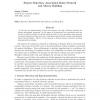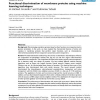115 search results - page 16 / 23 » Learning hierarchical task networks by observation |
IJCNN
2008
IEEE
14 years 1 months ago
2008
IEEE
—A novel wake-sleep learning architecture for processing a robot’s facial expressions is introduced. According to neuroscience evidence, associative learning of emotional respo...
JMLR
2010
13 years 2 months ago
2010
As the size and dimensionality of data sets increase, the task of feature selection has become increasingly important. In this paper we demonstrate how association rules can be us...
BMCBI
2008
13 years 7 months ago
2008
Background: Discriminating membrane proteins based on their functions is an important task in genome annotation. In this work, we have analyzed the characteristic features of amin...
WWW
2011
ACM
13 years 2 months ago
2011
ACM
Recently, a number of algorithms have been proposed to obtain hierarchical structures — so-called folksonomies — from social tagging data. Work on these algorithms is in part ...
RAS
2000
13 years 7 months ago
2000
A mobile agent with the task to classify its sensor pattern has to cope with ambiguous information. Active recognition of three-dimensional objects involves the observer in a sear...


